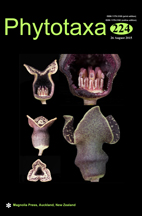Abstract
We describe, illustrate and compare with related species Calyptranthes anguerana, Eugenia altissima, E. caloneura, E. indistincta, E. mucugensis, E. rara, Myrcia alatiramea, M. hypophaea, M. petrophila, M. pseudovenulosa, M. ramiflora, M. trimera and M. unana. All species are presently known only from the state of Bahia, except Myrcia hypophaea, which extents northward until the state of Paraíba. Calyptranthes anguerana is related to C. concinna, differing through its monopodial and glabrous inflorescences; Eugenia altissima is apparently close to E. laruotteana, being distinguished by the larger flowers with ovaries glabrous inside; Eugenia caloneura is apparently related to E. leonorae, differing through its larger leaves and flowers buds with discrete calyx lobes; Eugenia indistincta is related to E.subavenia, differing by its pauciflorous inflorescences, smaller flowers and globose fruits; Eugenia mucugensis is related to E. sonderiana and E. luetzelburgii, being distinguished from the first by its wider blades, inflorescences with visible axes and longer pedicels, and from the second by its petiolate leaves and elliptic blades with midvein adaxially sulcate; Eugenia rara is apparently related to E. subterminalis, from which it is kept apart through its pilose flowers with calyx that tears irregularly at anthesis; Myrcia alatiramea is apparently related to M. anceps, being distinguished by its larger blades, pauciflorous inflorescences and flowers with calyx tube; Myrcia hypophaea is related to M. decorticans, but has subsessile leaves, abaxially darker blades and larger inflorescences; Myrcia petrophila is related to M. reticulosa, differing in its longer petioles, blades with rounded bases, pauciflorous inflorescences and pilose flowers; Myrcia pseudovenulosa is apparently related to M. venulosa, but has uniformly pilose flowers and bilocular ovaries; Myrcia ramiflora is apparently close to M. hirtiflora, differing through its larger blades and smaller, ramiflorous inflorescences; Myrcia trimera is related to Marlierea luschnathiana, but has larger and narrower blades, glabrous inflorescences, trimerous flower buds and flowers without petals, and Myrcia unana is close to M. maximiliana, but has narrower blades and larger calyx lobes. Additionally, conservation issues are briefly commented for each species.

